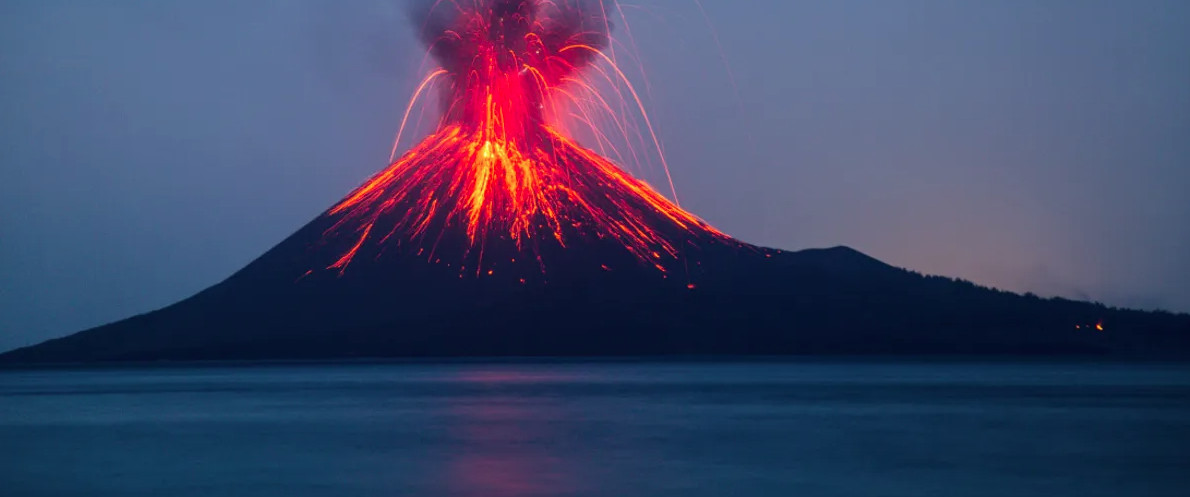If only they'd had noise-canceling headphones back in 1883.
At 10:02 am on August 27, 1883, an island in Indonesia collapsed as tsunamis sent 46-meter (151-foot) waves tearing into the ocean as far as South Africa. It marks the moment in history that the infamous Krakatoa volcano erupted, kicking off what’s thought to have been the loudest sound ever.
Krakatoa once sat midway between Java and Sumatra in Indonesia. It was a small, uninhabited volcanic island that rose up 838 meters (2,750 feet) above sea level and was last believed to be active in 1680 before rumblings began in 1883. The eruption in August released a force comparable to a 200-megatonne bomb, reports the Natural History Museum, and it had a far-reaching impact on people and the environment.
In terms of lives lost, Krakatoa (36,000) is the second most deadly eruption in modern history, with an 1815 eruption at Tambora that claimed at least 60,000 lives. The blast involved an extreme fluctuation in air pressure, something that – within certain ranges – is perceived as sound.
A barometer reading at a gasworks 160 kilometers (100 miles) from Krakatoa on that deadly day indicated the eruption clocked a drum-busting 172 decibels of sound from this distance. According to Nautilus, the human threshold for pain is 130 decibels, and each 10-decibel increase on top of that is registered like the noise doubling.
Given that a jackhammer reportedly clocks in at a measly 100 decibels, anyone at a distance of 160 kilometers from Krakatoa was going to have a bad time on August 27, 1883. Any closer, and things would get very dicey indeed.

The Tonga eruption was the loudest sound since Krakatoa, which happened 139 years earlier. Image credit: Japan Meteorological Agency, CC BY 4.0, via Wikimedia Commons
As the loudest sound ever tipped 194 decibels (the loudest sound possible in air) nearer the eruption site, that air pressure changed from a perceivable sound to a pressurized burst of air that ruptured the eardrums of sailors on a ship that was within 64 kilometers (40 miles) of the island.
“So violent are the explosions that the ear-drums of over half my crew have been shattered,” Discover reports the captain’s log of the British ship Norham Castle read. “My last thoughts are with my dear wife. I am convinced that the Day of Judgement has come.”
That same shockwave continued to fly across the planet growing quieter as it traveled farther, but it took some distance to peter out. According to Brüel & Kjær, it could still be heard like canon fire at a distance of 4,800 kilometers (3,000 miles) from Krakatoa.
The wave of pressure would go on to wrap around the globe three times in each direction, with shockwaves occasionally colliding elsewhere on the planet creating extra pressure spikes. “The great air wave”, as it became known, continued traveling around the planet for some time after it dropped below the threshold for humans’ hearing, and so ended the loudest sound ever.
The loudest sound since Krakatoa is believed to have been the Tonga eruption in 2022 whose sonic boom was heard all the way in Alaska, 6,200 kilometers (3,850 miles) away. Tonga also sent waves of sound and tsunamis tearing across the planet, with one pressure wave measured moving at over 1,100 kilometers (700 miles) per hour and reaching an altitude of 450 kilometers (280 miles) – that’s higher than the orbit of the International Space Station.
Fingers crossed Krakatoa stays the record for many centuries to come.
- aum and Mutton
-

 2
2




Recommended Comments
There are no comments to display.
Join the conversation
You can post now and register later. If you have an account, sign in now to post with your account.
Note: Your post will require moderator approval before it will be visible.